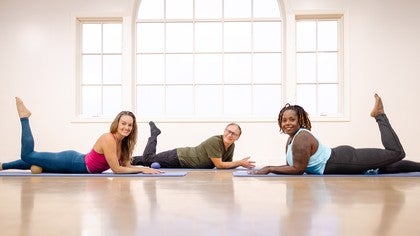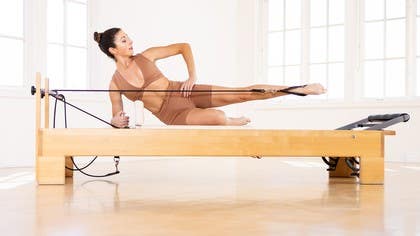
Pilates: How to Get Started
Help, I want to start Pilates but don’t even know where to begin!
Don’t worry. We’re here to guide you through all your options, so that you can get started with confidence.
WHY should I do Pilates?
The benefits are nearly endless, applying to all age groups and demographics – seriously, it’s all backed by science. We’ll spare you the need of having to read 20 case studies (unless you want to, of course), and tell you simply that Pilates has proven to:
- Decrease back pain
- Prevent falling due to better balance in the elderly
- Improve quality of life for cancer patients
- Increase flexibility
- Improve/enhance sex drive (especially for males)
- Improve BMI via muscle toning
- Improve pelvic stability
- Improve and speed up physical rehabilitation from orthopedic surgeries when compared to standard physical rehab methods for knee and hip injuries/surgeries
- Mitigate fibromyalgia pain
HOW do I do Pilates?
Pilates can be done with or without props; alone or with a group. Here are some examples of the different ways you can practice Pilates – at least one of which will fit both your budget and schedule:
1. Private Pilates Lessons
PROS: one-on-one lessons ensure that you are getting exactly what your body needs. You want to seek out a well-trained and certified Pilates teacher who can fully understand your body. They will be able to modify the exercises to meet your specific needs.
NOTE: Selecting your Pilates teacher is similar to selecting a hairstylist. You will communicate better with some than you do with others, and you will like some teaching styles over others. If you fall hard for the first teacher with whom you book a private session, stick with him/her! There is such a thing as love at first sight! But if you walk out feeling tense, frustrated, or disappointed you should schedule a session with someone else. You won’t regret playing the field to find “the one.”
CONS: only one – private Pilates sessions are indeed expensive. After all, you are spending time with an educated teacher who is giving you, and only you, their full attention for an hour. You will likely use at least one piece of Pilates apparatus: the Cadillac, a Ladder Barrel, and/or a Reformer. Teaching apparatus work requires comprehensive training and knowledge. You’re not paying for the hour. You’re paying for years of study and experience.
2. Group Pilates Reformer Classes
PROS: a more cost-effective solution over private Pilates lessons that still affords you the benefits of the apparatus. Though a Reformer class isn’t as comprehensive as a private, you will still gain similar benefits by using the resistance of the springs on the Reformer.
If you are a first-time Reformer student, be sure to arrive at least 15 minutes early. Let your teacher know you are a novice so that he/she can give you a rundown of the Pilates apparatus. You can also watch this video about how to set it up, but keep in mind that many Pilates studios will differ slightly by apparatus used, so it’s always a good idea to budget a bit of time to get to know your equipment, allowing you to get the most out of class!
CONS: you do not get the teacher’s full attention and you are working with apparatus with resistance, so you must be especially mindful of your joints and physical placement as to not injure yourself.
3. Group Pilates Mat Classes
PROS: even more affordable than group Reformer classes and usually offered as part of a standard gym schedule, so you often don’t even need to seek out specific studios. Mat classes tend to be the least intimidating of all Pilates, because they feel more like other classes you may have taken, such as a yoga, Barre, or stretch class. Some Pilates mat classes include just your body and a mat, while others include the use of small props such as a ball, ring, or band.
CONS: usually more crowded than Reformer classes, meaning that there is little individual attention and you’re often “on your own” when it comes to following cues and making sure you’re in proper alignment. Also, without the help of the springs, it can be harder to find the resistance in each exercise since you have to create this feeling by yourself.
4. Self-Taught Pilates
PROS: self-paced and can be fit in at whatever time, and in whatever timeframe, you need – thank you Internet!
Life is hectic – whether it’s your family, work, kids, social life, and everything else in between, you are busy. Sometimes 30 minutes at 5:30 AM before the kiddos are up or 30 minutes at 6:30 PM just before dinner at 7:00 is all you can manage. That’s the beauty of self-taught Pilates – you don’t need to worry about driving to a studio, or making it to a class on time (because really, who needs that added stress if you’re already stressed from being busy?!), or even getting dressed, since you’re at home.
Self-taught, being self-paced, gives you the time to really understand the principles. Are you not understanding how you’re supposed to inhale laterally instead of horizontally? Pause, rewind, and repeat as much as you need to (not exactly something you can do in a group class, right?!). Want to replay a move so you can ensure you’re doing it right? Pause, rewind, and repeat… you know the drill.
CONS: unless you are practicing with a friend who is also involved in Pilates, you can’t really step outside of your own body to ensure your alignment is fine-tuned – which is why we suggest practicing in front of a mirror.
In addition, because it’s self-paced, sometimes the motivation is lacking, and what was intended to be 60 minutes on your mat after work ended up being 60 minutes of Netflix on the couch. But you will get better at following your original intention by making Pilates a habit (by the way, it’s not 21 days – it’s more like 2-3 months, according to scientific and psychological studies) and/or staying motivated with Pilates challenges.
To set yourself up for Pilates success with a budget
We recommend:
- Schedule 2-3 private Pilates sessions with a Pilates teacher, so that you can get a full-body scan of your imbalances, what to work on, and how to make modifications based on them. Get used to working on the Tower, Cadillac, or Reformer so that if/when you take studio Reformer class, you are already familiar with the equipment and don’t spend half the class worrying if you’re even doing it right.
- If the budget allows, keep at least one private Pilates session per month, just to keep things in check.
- If the budget allows, take 1-2 Reformer group classes per week in studio (ClassPass is a great affordable option for this!). If not, simply take regular Pilates Mat (or self-taught) classes in place of the Reformer classes.
- 2-3 days per week, take an in-studio Pilates Mat class or a self-taught class at home.
Note: studio classes, and private sessions, are not required at all to start Pilates – you can start entirely self-taught, at home! We simply recommend this schedule as a basis for a safer plunge into Pilates.
Comments
No comments yet. Be the first!












You need to be a subscriber to post a comment.
Please Log In or Create an Account to start your free trial.